A Restless, Philosophical Quest: The Art of Arthur Monroe
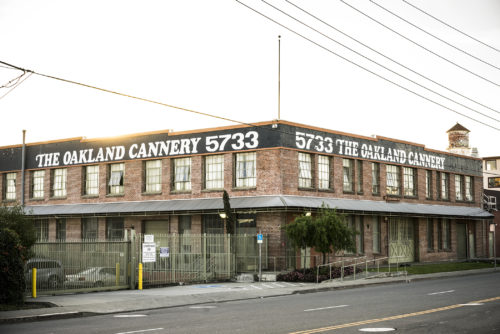
The Oakland Cannery lies on an industrial stretch of San Leandro Street alongside the rapid-transit BART tracks in East Oakland; amid a landscape of warehouses, auto repair shops, and RV camps, the building houses a complex of artists’ live/work spaces. The original settler and founder, a widely respected artist, educator, and community activist, is Arthur Monroe.
Climb two sets of stairs then head down a long corridor and the visitor arrives in Monroe’s capacious studio. To the right, a small kitchen stocked with provisions, a round oak table, a living area and, further back, a bedroom. The walls are covered with photos, posters and paintings, the shelves packed with hundreds of books. Evidence of Monroe’s ongoing aesthetic research lie all about. Every surface is covered with notebooks, pictures, shirts, hats, and found objects. There is a sense of generative clutter, a kind of chaos that no doubt makes total sense in the eye of the maker.
To the left, in a large, sky-lit studio, canvases of up to eight-feet square lean against pigment-spattered walls. The paintings of Arthur Monroe take the viewer by surprise. They are boldly physical, multi-layered abstractions in deep, vibrant reds, blues, yellows, browns, blacks, and whites. Gestural curves suggesting athletic sweeps of arm and hand stand out against hard-edged rectangular panels and dark, receding spaces.
“See, that painting there, that blue one?” said Monroe. “Goddamn, where do you get the nerve to make a subject matter as abstract as these are?”
Forms emerge before the viewer’s eyes, here a crisscross that might be an electrical tower, there the suggestion of a face. But there is no way to pin down the references; meaning remains multiple, elusive.
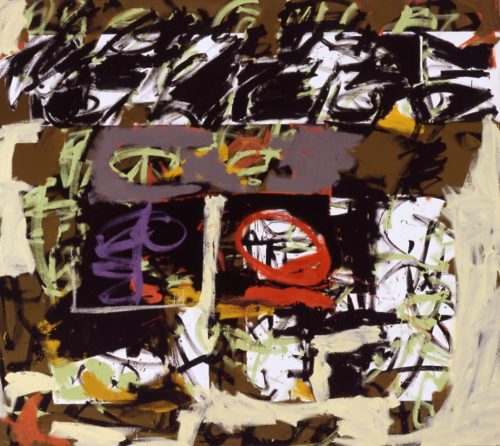
Arthur Monroe, Untitled; oil on canvas, 1986. Courtesy of Weigan Gallery, College of Notre Dame, San Mateo, California, 2004. Photo: John Wilson White.
Monroe was living in San Francisco’s North Beach in 1975 when he saw a newspaper ad for studio spaces in Oakland. “I jumped in my car and scooted over to the place,” he said. “I opened the door, looked inside, and right away I said, ‘I’ll take it!’” The 2,800 square-foot space was completely empty. Walls dividing work and living quarters, along with plumbing and shelving, were later designed and built by the artist.
For more than thirty years he has been quietly producing a large body of work from his Oakland Cannery studio. During most of that time he worked as chief registrar at the Oakland Museum of California.
In March of 2019, a major retrospective exhibition of his work went on display at 54 Washington Street in Jack London Square. The 6,000-square-foot space is being leased by the City of Oakland to community arts organizations on a rolling basis. The exhibit was produced and curated by Arthur’s son, Alistair Monroe, in partnership with Visit Oakland, a private non-profit focused on increasing the economic impact of tourism in Oakland.
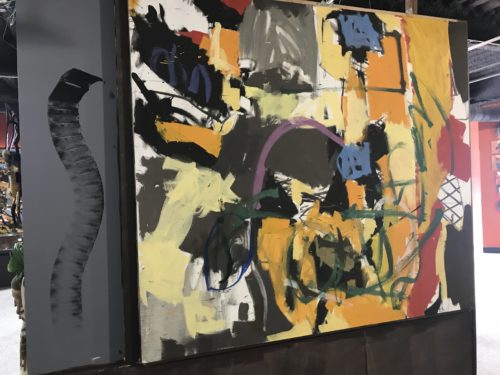
Arthur Monroe, Untitled; oil on canvas, 1998. On display at The Beat Generation Gallery. Photo: Kit Robinson.
The big room was hung with more than two dozen large canvases and many smaller works, along with African artifacts from the collections of some of Monroe’s close friends and photographs documenting his life and work. Music at the opening was provided by legendary jazz guitarist Calvin Keys and other Bay Area musicians. Attendees included members of Monroe’s large extended clan of family and friends, as well as city officials, fellow artists, art lovers, and random passersby.
In addition to the show, Alistair curated a celebration of the life of renowned jazz drummer Art Sharkey Lewis, who had died the previous week. Lewis and Monroe were close friends. Lewis’s wife, the artist Heidi McGurrin, a San Francisco debutante with family ties to the owners of the Nepenthe Restaurant in Big Sur, is the mother of Alistair Monroe.
Dubbed The Beat Generation Gallery, the exhibit was produced as a four-month pop-up and played host to several community events, including a fiftieth anniversary benefit concert for the Venceremos Brigade by the local Afro-Cuban charanga group Calle Ocho (full disclosure, my band), a concert by the popular East Bay salsa band Orquesta La Peña, and a closing ceremony featuring Congolese singer/songwriter Jacques Ibula. School and community groups also held events at the gallery ranging from storytelling and dance to a symposium on motherhood and mental health. The emphasis on music and community is consistent with Monroe’s cross-cultural aesthetics.
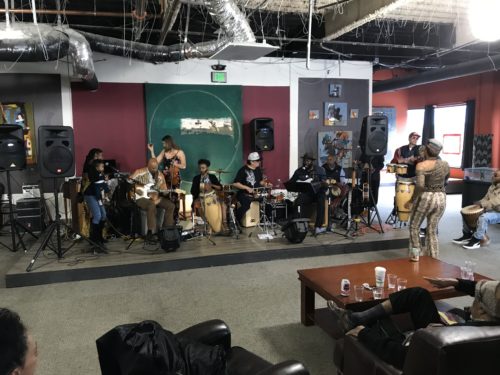
Congolese singer/songwriter Jacques Ibula and friends at The Beat Generation Gallery. Photo: Kit Robinson.
Arthur Monroe was born in Brooklyn on July 14, 1935. Early on, his grandmother, Julia Swindell, took note of his artistic bent. “From the beginning my grandmother was an encouragement,” he said. “But when I got older, she was more or less skeptical. She wanted me to do something more practical, but I never found out what that was.”
After graduating from Boys High School in the Bedford–Stuyvesant neighborhood, the young Arthur attended the Brooklyn Museum School. Following its philosophy of remaining free of academic pressures, the school never sought accreditation, yet its alumni include such artists as Marisol, Pat Adams, and Robert Smithson, and its teachers have included Ben Shahn, William Baziotes, and Max Beckmann.
“I was very happy to have gone there because they were wonderful people,” said Monroe. “Some of the most intelligent conversations I had about art happened there. The people there were very sharp and very critical.”
In the 1950s, he joined the life of the artist in Manhattan, frequenting both Harlem and Greenwich Village. “What I did after school wasn’t entirely easy,” he said, “but it wasn’t programmed either. You knew what you wanted to do, and you did it. Being in the Village, living as a bohemian, hanging out with artists and jazz musicians.”
The painter Harvey Tristan Cropper was one such artist. “We would sit in Harvey’s studio, which was a basement arrangement, kind of like a cellar. Harvey did some wonderful painting then. At times I would ask Harvey how to do this or how to do that. He was very generous, with me anyway.”
Cropper’s studio was around the corner from where Monroe was working as an errand boy at the Lawrence Fertig advertising agency. “I could just walk down the street and I would run into Harvey and the jazz musicians,” he said. “We were very close to the jazz musicians. I learned a lot from them.”
Through Cropper, Monroe came to know legendary saxophonist Charlie Parker, who played regularly at a favorite local hangout, the Open Door. Other friends included drummer Max Roach, poet Amiri Baraka (then LeRoi Jones), and poet/artist/gallerist Ted Joans. Together, Black poets, painters, and musicians were blazing artistic trails grounded in both African and Western traditions and techniques.
For a while, Monroe’s studio was across the hall from that of Willem de Kooning, and he knew Franz Kline and others of the Abstract Expressionist group who frequented the Cedar Tavern. But more often the painters, poets, and musicians of Monroe’s own circle were to be found at Café Rienzi on Macdougal Street.
“Why should only white people be Abstract Expressionists?” asked Monroe. “That’s ridiculous. And it has no legitimate academic credibility. The Abstract Expressionists were questioning everything except themselves. But I didn’t want to be the one to call them on the carpet, because the real truth of it is that I enjoyed Abstract Expressionism. I had a lot of work to do. And I still have a lot of work to do.”
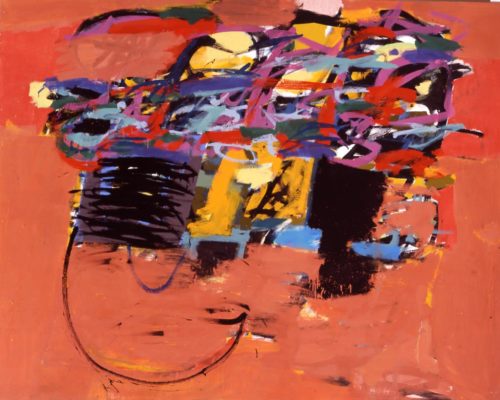
Arthur Monroe, Untitled; oil on canvas, 1990. Courtesy of Weigan Gallery, College of Notre Dame, San Mateo, California, 2004. Photo: John Wilson White.
Monroe’s art grows out of a restless, philosophical quest. “I started by asking what is a painting? Do you know? Well, I don’t either. But I make paintings!” He laughs. “If you are a painter you have to start solving problems. What should it have? Sometimes it’s a combination, a variety of things that you’ve experienced as a person. Other times it’s quite remarkably different from anything you know. How do you make a painting out of things you don’t know? These are interesting questions, and you don’t always know what the outcome is going to be. So you are saddled with that horrendous undertaking in a sense without actually having much of a conclusion about it.”
After a period tending a dairy farm in upstate New York, Monroe headed for Mexico. He stayed in Ajijic, a village on the shore of Lake Chapala in the State of Jalisco. The remote location and picturesque landscape of Ajijic has attracted such writers as D.H. Lawrence, Witter Bynner, and Alexander Trocchi. Then, in 1952, Monroe was drafted into the Army and stationed in Korea, where US troops were part of a UN police action defending South Korea against an invasion by North Korea with support by the People’s Republic of China and the USSR — otherwise known as the Korean War. His tour of duty coincided with the winding down of the war, which ended with an armistice and the demilitarization of the border. “I saw enough action to fire my weapon,” Monroe said. “I had to be ready to stand up and die.” A peace treaty was never signed.
On his return stateside, Monroe headed for Big Sur, the wild, mountainous country on California’s Central Coast; he would return there often. He settled in San Francisco’s North Beach, where he took part in the cultural ferment dubbed by Jack Kerouac as “the Beat Generation.” His friends included poet Bob Kaufman and poet/publisher Lawrence Ferlinghetti. It was Ferlinghetti who produced the first show of Monroe’s paintings at City Lights Bookstore.
In the early 1960s, Monroe returned to Mexico, living and painting for three years in Ajijic. There he met Bay Area poet Al Young. In a 1969 newspaper interview, Young recalled, “At that time Ajijic was crammed with hippies […] Arthur was one of the beatniks who had sort of lasted into the hippie era […] The Mexicans loved him. They called him by one name: Arturo. He was a very romantic figure, wearing the Mexican straw hat that the peasants wore. He was painting, and he was highly respected.” 1
Back in North Beach, Monroe received a visit to his studio by Reidar Wennesland, a Norwegian physician and art collector who, as a young man, had treated Edvard Munch. Dr. Wennesland was the most important patron of 1950s and 1960s San Francisco avant-garde painters, including Jay DeFeo, Jess Collins, and George Herms. The main artists of Dr. Wennesland’s collection, which includes more than 200 works, are Arthur Monroe and his studio mates Michael McCracken and Michael Bowen. Offers were later made to four Bay Area museums to donate the collection in exchange for an agreement to display the work. All declined. 2
The Wennesland Collection was willed to Kristiansand Cathedral School and Adder University College in Wennesland’s hometown on Norway’s southern coast, where it can be seen today.
In 1968, after a spell tending Dr. Wennesland’s farmhouse in Santa Cruz, California, Monroe traveled to Latin American with Heidi McGurrin. They settled first in San Miguel de Allende, Mexico, then in Santiago, Chile, where they spent several months studying and creating art.
Alistair remembers, in the 1970s, staying in the house built by the renegade Catalan linguist and poet Jaime de Angulo. Saxophonist Charles Lloyd was a neighbor and friend during his famous self-imposed sabbatical from the music business. Alistair grew up in nearby Sycamore Canyon, not far from Pfeiffer Beach.
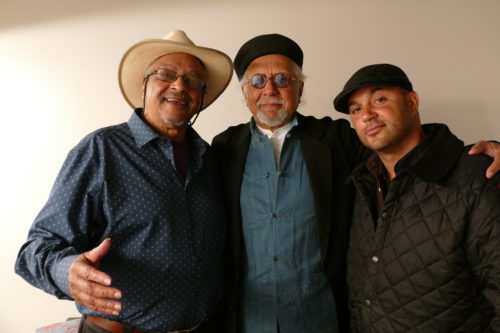
Arthur Monroe, Charles Lloyd, and Alistair Monroe.
During his tenure as registrar at the Oakland Museum, Monroe’s social circle of Black intellectuals included Barbara Christian, professor of African American studies at Berkeley, and her husband, poet David Henderson, as well as painters and sculptors Oliver Jackson, Dewey Crumpler, Mary Lovelace O’Neal, and Evangeline Montgomery. Monroe was also a member of the Breakfast Group, a loose association of artists teaching at Berkeley who met weekly to discuss art, teaching, film, politics, and sports. Among them, Monroe formed a lasting friendship with the figurative painter Terry St. John, with whom he taught at the Oakland Museum.
He was also close with Carl Anthony, architect, regional planner, and founder of Urban Habitat, an organization committed to a just and connected Bay Area for low-income communities and communities of color. In 1992, Monroe edited the first issue of Urban Habitat Reader, a collection of articles on environmental issues including healthcare, toxins, racism, transit, water, and regional planning.

Arthur Monroe, Untitled; oil on canvas, 1980. Courtesy of Weigan Gallery, College of Notre Dame, San Mateo, California, 2004. Photo: John Wilson White.
The Oakland Cannery was built in the 1930s as a fruit cannery, and later hosted haberdasheries and other trade-related businesses. In 1975, with the live/work trend already in full swing in New York City and elsewhere, the owner decided to lease out the upper floor of the warehouse complex to artists.
“It wasn’t a live/work space at that time,” said Monroe. “I had to go down to the City Council and work out a deal. We really had to fight for our space.” After first threatening to shut down the building, the Council relented and allowed the artists to stay on the condition that they make the place livable. Since then Monroe has made it his mission to help convert warehouses into legally permitted artist live/work studios.
Recently the Cannery artists faced a new threat. A cannabis real estate development firm bought the Oakland Cannery in 2017, unbeknownst to its tenants. Eviction notices followed. Through efforts organized by Arthur and Alistair Monroe, the City Council passed amendments to the city’s cannabis ordinances resulting in protection for Cannery residents as well as more than one hundred buildings and two thousand homes in the East Oakland community.
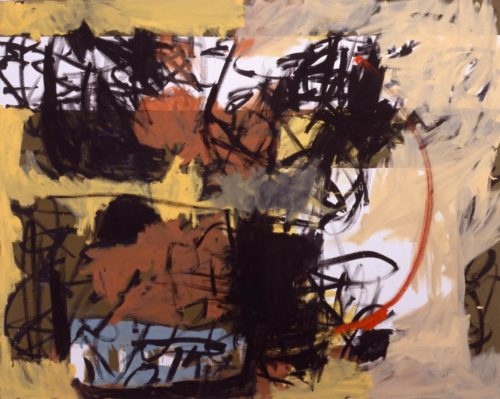
Arthur Monroe, Untitled; oil on canvas, 1980. Courtesy of Weigan Gallery, College of Notre Dame, San Mateo, California, 2004. Photo: John Wilson White.
During their effort to influence city policies against the displacement of local artists, Arthur and Alistair were contacted by the Smithsonian Institution Archives to arrange for the acquisition of Arthur’s works, as well as his archive of papers, which include personal journals and extensive writings on art history and theory. The Smithsonian deal may help to answer a question Arthur Monroe has been posing for most of his life: “Why aren’t African-American artists associated with Abstract Expressionism?”
“Why shouldn’t they be?” asked Monroe. “Isn’t jazz abstraction? Don’t Black artists have something special to contribute? The African-American experience supplies them with intrinsic qualities of expression and sanctuary. Their art is anchored and given substance by the groundwork of African civilization.”
Arthur Monroe’s career fills in a missing piece in the history of modern art, the ascension of Black Abstract Expressionism. Why, we might ask, has this piece remained missing? It’s a simple question with no simple answer. Things happen — or don’t happen — for multiple reasons. The obvious answer — the elephant in the room — is racism.
Abstract Expressionism gained ascendancy in the 1950s, well before the Civil Rights Movement, when the art world was as white as the pristine walls of its galleries and museums remain today. Exceptions like Jacob Lawrence and Romare Bearden, often abstract in execution, remained representational in their strategies. While Monroe knew and interacted with several of the iconic painters of the Abstract Expressionist movement, he was never admitted into its society of artists, gallerists, and curators.
After a run of shows in the early 1970s including the Vorpal Gallery in San Francisco, the University of Santa Clara, the University of Iowa, and the Oakland Museum, and jobs teaching in African American studies departments at the University of California at Berkeley and San Jose State University, Monroe withdrew to his studio to paint. While the Abstract Expressionist canon continued to circulate, and demand top prices, new trends and forms captured the attention of critics.
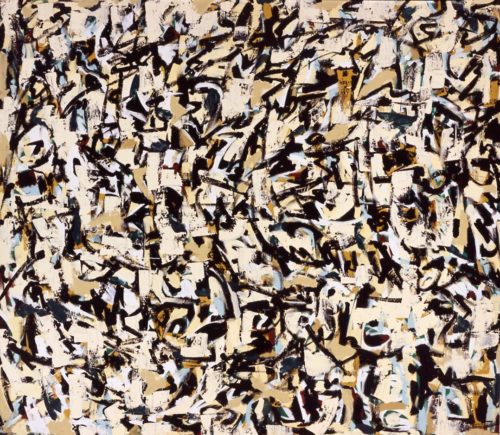
Arthur Monroe, Untitled; oil on canvas, 1983. Courtesy of Weigan Gallery, College of Notre Dame, San Mateo, California, 2004. Photo: John Wilson White.
A dazzling show of Monroe’s paintings took place at the Weigan Gallery at College of Notre Dame in San Mateo in 2004. Since then a few of his canvases have appeared in group shows, at the Museum of the African Diaspora in San Francisco in 2012, and the Richmond Art Center in 2014, but there has been no retrospective until the recent pop-up exhibition in Jack London Square. One might ask, is it too late? Is Abstract Expressionism passé? Or can our excitement for abstract painting be renewed through the reclamation of long neglected yet masterful work?
Arthur Monroe’s probing, questioning mind, sure hand, and exuberant spirit communicate something vital that we have been missing. We didn’t know what we were missing, and now here it is, a burst of energy, grounded in disciplined practice and full of life.
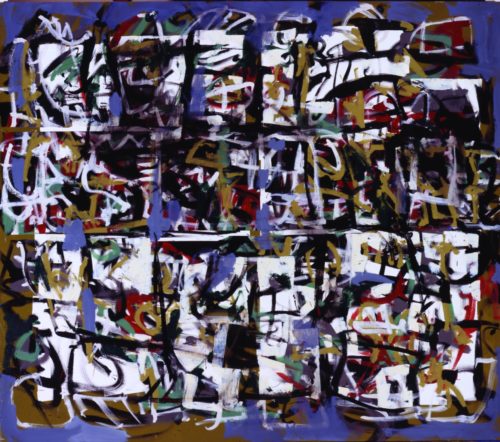
Arthur Monroe, Untitled; oil on canvas, 1983. Courtesy of Weigan Gallery, College of Notre Dame, San Mateo, California, 2004. Photo: John Wilson White.
- Tony Burton, "Painter Arthur Monroe honed his creativity at Lake Chapala in the early 1960s," Lake Chapala Artists.
- Matt Smith, “Beat Back: An extraordinary collection of San Francisco avant-garde art is hanging in a Norwegian school. Why not here?” SF Weekly, March 22, 2006.
Comments (7)
-
tom schultz says:
April 26, 2020 at 3:28 pm
-
Pierre Loving says:
January 8, 2020 at 12:53 pm
-
Andre Ptaszynski says:
December 4, 2019 at 4:52 pm
-
Lawrence Hultberg says:
November 5, 2019 at 1:02 pm
-
Rodney Koeneke says:
November 2, 2019 at 5:17 pm
-
Steve Benson says:
November 1, 2019 at 1:15 pm
-
Leslie W. Trimble says:
November 1, 2019 at 12:11 pm
See all responses (7)I knew Arthur from the 60s, his work has so much energy,it goes outside the canvas.” a true abstract expressionist”. he said at the breakfast group his influence was Charlie Parker
As an unrecognized artist of color, who contributed greatly to the Abstract Expressionists movement, Arthur Monroe left a legacy of work that has yet to be recognized in the manner as his recognized peers. It is wonderful that Dr. Reidar Wennesland perceived the value in his work and saw fit to preserve a large body of it, albeit in Norway. Shouldn’t more of it be more recognized and preserved here where it was created?
I was able to buy a self-portrait of Arthur Monroe’s for $200 at the Kala
Institute: what an amazing deal! I did not know his work and history until I researched this treasure. Now I’m in love with his work and so sad to learn that he’s left us.
At age 75 I’m restarting my painting life and following his inspiration.
Rest In Peace Arthur.
Just learned the sad news. Arthur was an old friend of my parent’s from back east during the seminal days of the New York art scene when I was very young. I didn’t get to know him personally until we met many years later in the San Francisco Bay Area where we were both living. I visited him in Oakland and he would attend openings at my SF gallery from time time. Arthur had strong informed opinions and philosophical perspectives about art and I was honored to receive advice from him, some that I took to heart. I’m looking at a painting of his as I write this, which is one of the highlights of my personal collection. The art world has lost a bright light of a woefully underappreciated artist.
Thanks for this sharp portrait, Kit, and thanks to Arthur for these striking paintings. I just got word that we lost him, the same week this piece appeared. I’m glad to think he got to see it on Open Space.
Arthur Monroe’s life and work and fantastically energetic, principled, and generous. I’m so glad to find out about him and his work.
Arthur will be missed,and saddened by his transition, I know his spirit lives in all whose lives he touched! He was a remarkable man!